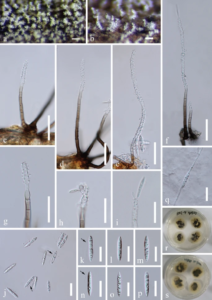Pseudodactylaria longidenticulata J. Yang, E.B.G. Jones & K.D. Hyde, in Yang, Liu, Jones, Hyde, Liu, Bao, Liu, Li, Shen, Yu & Liu, Fungal Diversity 119: 166 (2023)
Index Fungorum number: IF 559823; MycoBank number: MB 559823; Facesoffungi number: FoF 12834.
Etymology – referring to the long and denticulate conidiogenous cells.
Holotype – MFLU 22-0075
Saprobic on decaying submerged wood in freshwater. Asexual morph: Colonies on wood effuse, hairy, scattered or aggregated, brown, with glistening conidial masses at the apex. Mycelium partly superficial, partly immersed, composed of septate, smooth, pale brown to hyaline hyphae. Conidiophores macronematous, mononematous, erect, straight or flexuous, cylindrical, smooth-walled, septate, unbranched, brown, paler to hyaline towards the apex, thick-walled, (55–)80–130(–175) × 3.2–4.7 µm (x̄ = 117 × 3.8 µm, n = 20). Conidiogenous cells polyblastic, integrated, terminal, indeterminate, cylindrical, denticulate, hyaline, 20–145 × 2.7–4.8 µm. Conidia pleuroacrogenous, narrowly fusiform, uniseptate, smooth, guttulate, hyaline, 18–27 × 3.3–4.5 µm (x̄ = 24 × 4 µm, n = 30), thin-walled, usually with a hyaline, irregular appendage. Sexual morph: Undetermined.
Culture characteristics – Conidia germinating on PDA medium within 24 h. Germ tubes produced from both ends. Colonies on PDA medium reaching 10–15 mm diam. after 2 weeks at 25 °C in natural light, circular, with dense mycelium on the surface, dark brown in the middle, white at the edge; in reverse dark brown in the middle and white at the entire margin.
Material examined – THAILAND, Rayong Province, Klaeng, on decaying wood submerged in a freshwater stream, 24 April 2017, Y.Z. Lu, RAY-4 (MFLU 22-0075, holotype; HKAS 112644, isotype), ex-type cultures MFLUCC 17-2383 and GZCC 20-0411.
Notes – Pseudodactylaria longidenticulata is distinguished from other species in the genus by longer conidiogenous cells (Table 7). In the phylogenetic tree (Fig. 53), Pseudodactylaria longidenticulata was positioned as a sister taxon to P. uniseptata. They differ by the dimensions of conidiophores and conidiogenous cells (Table 7). Comparisons of the LSU, ITS, TEF1α, and RPB2 gene regions of P. longidenticulata and P. uniseptata showed five bp (876/881 bp, one gap), 20 bp (501/52 1 bp, two gaps), 37 bp (893/930 bp) and 68 bp (972/1040 bp) differences, respectively. Therefore, Pseudodactylaria longidenticulata is introduced as a new species based on the morphology and molecular DNA data.

Figure 1. Pseudodactylaria longidenticulata (MFLU 22-0075, holotype). a, b Colony on wood. c–f Conidiophores. g Conidiogenous cell. h, i Conidiogenous cells with conidia. j–p Conidia, arrows indicate appendages. q Germinated conidium. r, s Culture, r from above, s from below. Scale bars: a, b = 100 µm, c–f = 30 µm, g–j, q = 20 µm, k–p = 15 µm.
